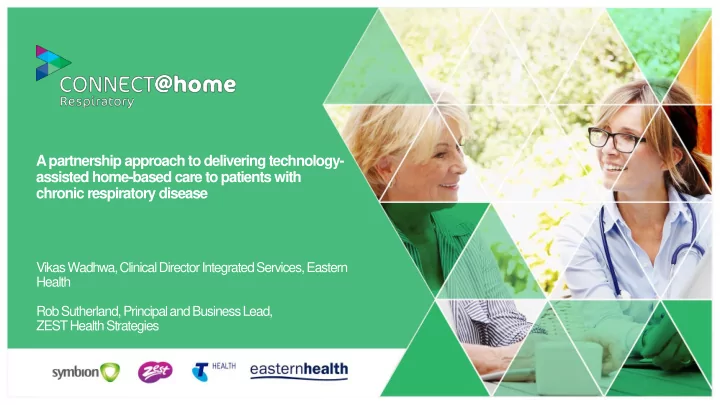

A partnership approach to delivering technology- assisted home-based care to patients with chronic respiratory disease Vikas Wadhwa, Clinical Director Integrated Services, Eastern Health Rob Sutherland, Principal and Business Lead, ZEST Health Strategies
Background Chronic Respiratory Diseases Hospital Admission Risk Programs (HARP) • Promote independence • Second leading cause of • Reduce risks of avoidable hospital hospitalisation admissions in Australia • Resource intensive • Economic impact of Chronic • Regular home visits by Obstructive Pulmonary Disease specialist nursing teams in 2008: $98 billion
Consortium to develop EMOC EASTERN HEALTH SYMBION HOSPITALS TELSTRA HEALTH ZEST HEALTH STRATEGIES + + + Patient recruitment, Software and Service development & Collaboration, Expertise HARP service, Clinical Technology redesign, Research & governance Evaluation
Case Study Patient 1
Case Study -Age 37, smoker -Asthma preventer, occasional ventolin Patient 2 -2 hospitalisations previous 12 months, ICU -HARP Respiratory Case Management -Respiratory Connect home Project
Study design and Study Design methodology ▪ 12 month trial: Aug 2018- Aug 2019 ▪ Quasi-experimental Objectives 1. Reduce frequency of respiratory- related hospital readmissions/ED presentations 2. Improve patient adherence to care : plan tasks 3. Reduce average no. of home visits 4. Reduce overall cost of home-based care & support
The App Technology 1. Cross Platform (iOS & Android) 2. BYOD or provisioned devices 3. Zero rated data for Telstra customers 4. TGA approved Bluetooth devices 5. SaaS model Functionality 7 1. Task reminders 2. Health Questionnaires/Surveys 3. Biometric data – Bluetooth and/or manual data entry 4. Medication reminders – AMT integration 5. Triage dashboard
Co-design and change management • Change management and implementation support tailored to the local health service context Our approach: ✓ Shared governance model ✓ Co-design with the clinical team ✓ Process and patient journey mapping ✓ How-to-guides for patients and HARP staff ✓ Customisation of the technology (alerts for symptoms, Sp02)
Eastern Number of patients Health • n=79 Demographics • 77% female (n=61) • Mean Age 65 years • Age Range 21-96 • 23% male (n=18) • Mean Age 65 years • Age Range 20-85 Principle referral source • Acute Hospital (72%) • Respiratory OPD (13%) • Other (15%)
10
34% 57% 53 34 66% % % 11
Enhanced model of care: Preliminary Outcomes Care Plan Healthcare Direct Cost Savings Adherence Utilisation >$23 000 Average cost of avoided events >1 87% avoided ED presentations/ Return on Investment month 42% Tasks completed 15 Avoided ED Dollars saved in avoided events: as scheduled presentations Dollars Invested in technology
Enhanced model of care: Patient experience Patient perceptions Self-management of Health service-seeking respiratory condition of care behaviours “Sometimes when you’re not “I feel more “You can see the days well you doubt yourself. Many comfortable as I know you're abnormal and normal... times I’ve been sick and should the [nurses] are that's helpful as I could look back have called an ambulance and looking at my and say, Wednesday, Thursday, haven’t... with the technology if readings… that gives Friday my readings were you get bad someone will ring abnormal, but this week it’s all me confidence” and say you need to get an good. What have I done ambulance. Being told like this differently this week to last means I’ll do it. ” week?”
Case Study - Outcome -Action plan, GP visit organised -Only 1 respiratory presentation to ED 7 months; nil Patient 1 admissions -Reduction of carer stress -Reduced anxiety -Better recognition of symptoms and proactive in care
Case Study - Outcome -No further ED presentations or admissions -Reduced Ventolin Patient 2 -Return to work fulltime whilst being monitored -Activated Asthma Action Plan with Telephone Review initiated through Telehealth Data -Anxiety relieved
Learnings and future directions Change EMR/PAS Software Smartphone Scaling Up management Integration Access Optimisation Hospital In The Bluetooth pairing, Home, Diabetes PRN medications, Palliative Care, Cardiology further device integration
Acknowledgements Suzanne Morony Rob Sutherland Tracey Hart Frank Thien Zoltan Kokai William Grant Vickie Irving Eastern Telstra ZEST Health Health Nicola Man Mary West Vikas Wadhwa Ryder Manson 17 Symbion Sue Sinclair Jim Darcy Dean Martin
Recommend
More recommend